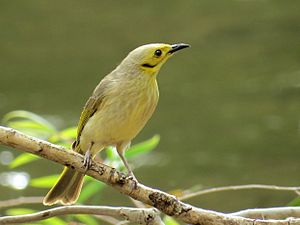Ptilotula facts for kids
Quick facts for kids Ptilotula |
|
|---|---|
 |
|
| Yellow-tinted honeyeater (Ptilotula flavescens) | |
| Scientific classification |
|
| Kingdom: | Animalia |
| Phylum: | Chordata |
| Class: | Aves |
| Order: | Passeriformes |
| Family: | Meliphagidae |
| Genus: | Ptilotula Mathews, 1912 |
Ptilotula is a group of birds known as honeyeaters. These birds live in Australia and Papua New Guinea. There are six types of Ptilotula honeyeaters.
For a long time, these birds were part of a different group called Lichenostomus. But scientists used special tests to study their DNA. These tests showed that Ptilotula birds were different enough to have their own group. The International Ornithologists' Union agreed with this change in 2013.
The most well-known bird in this group is the yellow-tinted honeyeater. Ptilotula birds usually live in dry forests and woodlands. You can find them in places that are dry or partly dry.
Contents
Meet the Ptilotula Species
There are six different kinds of birds in the Ptilotula group:
- Yellow-tinted honeyeater (Ptilotula flavescens)
- Grey-headed honeyeater (P. keartlandi)
- Yellow-plumed honeyeater (P. ornata)
- Grey-fronted honeyeater (P. plumula)
- Fuscous honeyeater (P. fusca)
- White-plumed honeyeater (P. penicillata)
What Ptilotula Birds Look Like
Ptilotula species are medium-sized honeyeaters. They are usually between 13 cm and 18.5 cm long. To give you an idea, 13 cm is about the length of a pen.
The yellow-tinted honeyeater is the smallest, at 13–15.5 cm. The yellow-plumed honeyeater is the largest, at 14–18.5 cm.
All Ptilotula birds have some special features. They have a plain face with a black stripe near their beak. They also have yellow or white feathers on the sides of their neck. These feathers look like plumes.
How Scientists Group Ptilotula Birds
For a long time, Ptilotula birds were part of the Lichenostomus group. Scientists noticed they looked similar and lived in similar places.
In the early 2000s, scientists did many molecular phylogenetic studies. This means they looked at the DNA of honeyeaters. These studies showed that the Lichenostomus group was too big. It needed to be split into seven smaller groups.
The Name Ptilotula
The name Ptilotula was first suggested by an Australian bird expert named Gregory Mathews in 1912. Before this, most honeyeaters were put into just two groups: Meliphaga or Melithreptus.
Mathews tried to make things clearer. He put 14 species into a group called Ptilotis. But he soon realized this group was not quite right. So, he created new groups from Ptilotis. He placed the white-plumed honeyeater and the yellow-tinted honeyeater into Ptilotula.
However, other bird experts did not agree with Mathews at first. They thought he was creating too many new groups. So, for a while, these birds stayed in the Meliphaga group. Ptilotula was just considered a smaller part of Meliphaga.
But Mathews kept using Ptilotula as a main group in his later work. He added the grey-headed honeyeater, the yellow-plumed honeyeater, and the grey-fronted honeyeater to it.
Modern Discoveries
In 1975, another Australian bird expert, Richard Schodde, said that the rules for the Meliphaga group were too broad. He split Meliphaga into three groups. He put the Ptilotula birds into Lichenostomus.
Later, new DNA studies supported Schodde's idea. They showed that Ptilotula birds were a distinct group. But early DNA methods were not strong enough to make them a completely separate group from Lichenostomus.
By 2010, newer DNA techniques were much better. They clearly showed that Lichenostomus needed to be reviewed. In 2011, scientists Nyari and Joseph finally proved that the Ptilotula group should be its own genus. Their research confirmed what Mathews had suggested many years ago. They also added the fuscous honeyeater to the Ptilotula group.
They also found that three other Lichenostomus species were closely related. These were the varied honeyeater, singing honeyeater, and mangrove honeyeater. But these three birds are much larger (16–24 cm). They also have a black band from their beak through their eye. This band is not found in Ptilotula birds. So, scientists decided to put these three birds into their own new group called Gavicalis.
Where Ptilotula Birds Came From
Ptilotula birds likely came from an ancient bird that lived in dry woodlands in central Australia. Scientists found a fossil leg bone in Queensland. This bone belonged to an ancient bird from a time called the Pliocene epoch.
The fossil bone is similar in size to the leg bones of the grey-headed honeyeater and the grey-fronted honeyeater. These two species live in that area today and are closely related. The area has been dry woodland for a very long time. This suggests that the fossil might be from an ancestor of these modern Ptilotula species.
See also
 In Spanish: Ptilotula para niños
In Spanish: Ptilotula para niños

